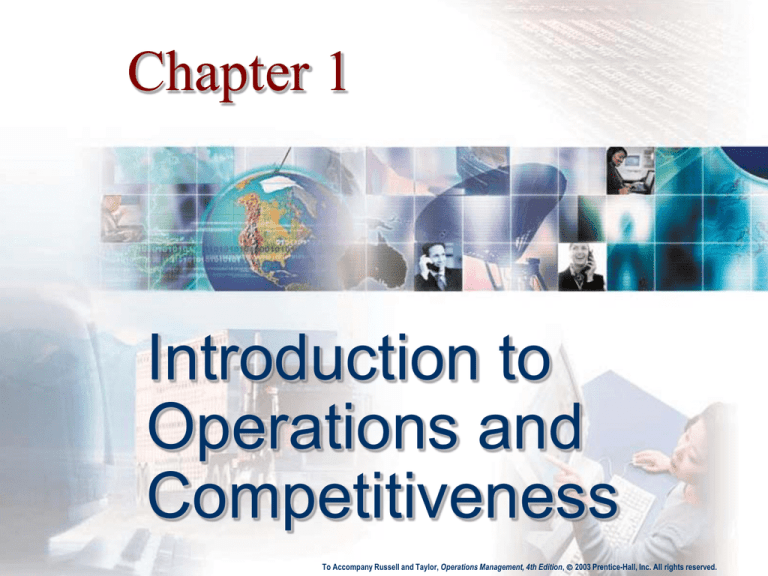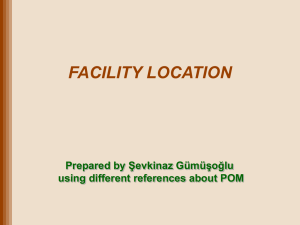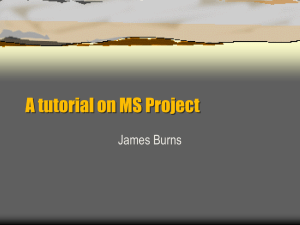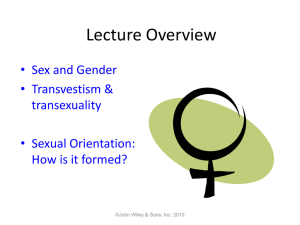
Chapter 1
Introduction to
Operations and
Competitiveness
Copyright 2006 John Wiley & Sons, Inc.
To Accompany Russell and Taylor, Operations Management, 4th Edition, 2003 Prentice-Hall, Inc. All rights reserved.
Welcome to ISQS 3344
Instructor: Dr. Burns
Spring 2015 SEMESTER
Telephone: 834-1547
Email: jburns@ba.ttu.edu
Off hrs: by appointment
Website: burns.ba.ttu.edu
Copyright 2014 John Wiley & Sons, Inc.
My web site
http://burns.ba.ttu.edu
From there you can navigate to the ISQS
3344 WEBPAGE
Copyright 2014 John Wiley & Sons, Inc.
1-3
Prerequisites
STATISTICS
Basic Statistical Concepts
COMPUTER LITERACY
MS Excel
MS Word
Copyright 2014 John Wiley & Sons, Inc.
1-4
Seating
The seat you sit in on the second
session of class will be your seat for the
duration of the class
A seating chart will be ‘made-up’ then
Copyright 2014 John Wiley & Sons, Inc.
1-5
Copyright 2006 John Wiley & Sons, Inc.
1-7
Requirements/Pedagogy
Two EXAMS and a FINAL EXAM
Three homework sets
Collected the day before we do our review
TO GET US READY TO TAKE THE EXAMS
Three Reviews
Performed the day before we take the exams
TO GET US READY TO TAKE THE EXAMS
Copyright 2014 John Wiley & Sons, Inc.
1-8
Term Project: Enabling you to
get a head start on your dream
Teams of three or four
“Teamwork makes the ______work”
Six parts to the term project
Copyright 2014 John Wiley & Sons, Inc.
1-9
The projects’ six parts
Part 1—Design of the Firm & its Products
Part 2—Strategic Quality Design
Part 3—Design of the Internal Processes
Part 4—Design of the External Processes
Part 5—Design of the Inventory/Forecasting
Part 6—Design of the Startup Project
Copyright 2014 John Wiley & Sons, Inc.
1-10
The projects’ six parts are due:
Proposal—1/22/2015
Part 1—2/5/2015
Part 2—2/17/2015
Part 3—2/24/2015
Part 4—4/9/2015
Part 5—4/16/2015
Part 6—5/5/2015 -- along with the total project
Copyright 2014 John Wiley & Sons, Inc.
1-11
Project Proposal
Team members
What product/service is being
contemplated?
Why is this needed?
What is unique about this product/service?
Must be approved/won’t be graded
Copyright 2014 John Wiley & Sons, Inc.
1-12
Grading
The homework is worth a total of 16%
Each EXAM is worth 16%
{There are two EXAMS}
The FINAL is worth 17%
The project is worth 29%
Attendance and participation is worth 6%
Copyright 2014 John Wiley & Sons, Inc.
1-13
Grades
90-100---A
80-89.999---B
70-79.999---C
97.5-on up---A+
92.5-97.4999---A
90-92.4999---ACopyright 2014 John Wiley & Sons, Inc.
1-14
Class Pedagogy
Won’t show any movies
Video clips are OK, however
PowerPoint
Simulations, where possible
Lectures--more informal
Interactive Discussions
Copyright 2014 John Wiley & Sons, Inc.
1-15
About your professor…..
Have taught this course for more than 20
years
Finds the content of this course
fascinating
…..my view of this course and the
world…
Copyright 2014 John Wiley & Sons, Inc.
1-16
The 100 best jobs today (US News
Rankings – 2015)
http://money.usnews.com/careers/bestjobs/rankings/the-100-best-jobs
Copyright 2014 John Wiley & Sons, Inc.
1-17
Questions
How big is the U.S. economy in terms of
GDP? What is the world-wide GDP?
How big is the U.S. population in relation
to the rest of the world?
What percentage of worldwide
nonrenewable resources are consumed
just in the U.S. alone?
Copyright 2014 John Wiley & Sons, Inc.
1-18
More questions
Is the U.S. leadership in terms of
material standard of living sustainable?
What does it take to make it sustainable?
What is causing the devaluation of the
dollar? Will that devaluation continue?
Is there anything good that comes from
devaluation of the dollar?
What’s bad about the $ devaluation?
Copyright 2014 John Wiley & Sons, Inc.
1-19
What are some of the biggest
problems our country (U.S.A.)
faces?
The war on terror
Mexican border out of control
The national debt; the budget and trade deficits
Contributions to global warming
High energy costs
Health care is too expensive
Major employers like banks are tanking
Copyright 2014 John Wiley & Sons, Inc.
1-20
What solutions do you foresee to
America’s problems?
Massive Jobs growth (particularly high-value jobs) and
Immigration of tax-paying, foreign professionals
Strong productivity growth
Sell Resources owned by the Federal Gov.
Oil on Federally-owned lands
Gas on Federally-owned lands
Coal on Federally-owned lands
Uranium on Federally-owned lands
Electricity (solar and wind farms on federally-owned land)
BUY AMERICAN
Copyright 2014 John Wiley & Sons, Inc.
1-21
The National Debt
Officially, $ 17,455,325,678,402.07 as of today
accumulating at the rate of $3.5 billion per day-$139,250 per taxpayer
According to Kotlikoff, the fiscal gap is a stunning
$65.9 trillion—that is more than twice the total net
worth of the entire country
Social Security and Medicare liabilities are
estimated at $40 trillion
No plans for accommodation of the retirements in
77 million baby boomers beginning now, but
becoming substantial after 2014
Copyright 2014 John Wiley & Sons, Inc.
1-22
Solutions--Kotlikoff
Copyright 2014 John Wiley & Sons, Inc.
1-23
Competitiveness
The opportunities are huge
There will be massive change
You can exploit that change to create
wealth
Copyright 2014 John Wiley & Sons, Inc.
1-24
Standard of Living
Jobs
Competitiveness
Cycle Time
Productivity
Cost
Quality
Operations
Creativity
Innovation
Copyright 2014 John Wiley & Sons, Inc.
Improvement
Design
1-25
What are some OM entry-level
titles?
PROJECT MANAGER
BUSINESS PROCESS ANALYST
INVENTORY ANALYST
PROJECT COORDINATOR
UNIT SUPERVISOR
SUPPLY CHAIN ANALYST
MATERIALS MANAGER
QUALITY ASSURANCE SPECIALIST
PRODUCTION SCHEDULER
LOGISTICS PLANNER
Copyright 2014 John Wiley & Sons, Inc.
1-26
Competitiveness, Productivity,
Leanness, Agility and Maturity
That’s what this course is about
Creating wealth through production of
goods and services
Copyright 2006 John Wiley & Sons, Inc.
1-27
Copyright 2006 John Wiley & Sons, Inc.
1-29
Copyright 2006 John Wiley & Sons, Inc.
1-30
Chapter 1
Introduction to Operations and
Supply Chain Management
Russell and Taylor
Operations and Supply Chain Management,
8th Edition
Lecture Outline
The Operations Function – Slide 8
The Evolution of Operations and Supply Chain
Management – Slide 13
Globalization – Slide 21
Productivity and Competitiveness – Slide 25
Strategy and Operations – Slide 30
Organization of the Text – Slide 45
Learning Objectives of this Course – Slide 47
© 2014 John Wiley & Sons, Inc. - Russell and
Taylor 8e
1-39
Learning Objectives
Describe what the operations function is and how it
relates to other business functions.
Discuss the key factors that have contributed to the
evolution of operations and supply chain management.
Discuss how and why businesses operate globally, and
the importance of globalization in supply chain
management.
Calculate and interpret productivity measures used for
measuring competitiveness.
Discuss the importance of operations and supply chain
management to a firm’s strategy, and the process of
developing, aligning and deploying strategy.
© 2014 John Wiley & Sons, Inc. - Russell and
Taylor 8e
1-40
Operations Management
• What is Operations Management?
design, operation, and improvement of productive
systems
• What is Operations?
a function or system that transforms inputs into
outputs of greater value
What is a Value Chain?
a series of activities from supplier to customer that add
value to a product or service
© 2014 John Wiley & Sons, Inc. - Russell and
Taylor 8e
1-41
Transformation Process
• A series of activities along a value chain extending from
supplier to customer
• Activities that do not add value are superfluous and
should be eliminated
© 2014 John Wiley & Sons, Inc. - Russell and
Taylor 8e
1-42
Transformation Process
• Physical: as in manufacturing operations
• Locational: as in transportation or warehouse
operations
• Exchange: as in retail operations
• Physiological: as in health care
• Psychological: as in entertainment
• Informational: as in communication
© 2014 John Wiley & Sons, Inc. - Russell and
Taylor 8e
1-43
Operations as a
Transformation Process
INPUT
•Material
•Machines
•Labor
•Management
•Capital
TRANSFORMATION
PROCESS
OUTPUT
•Goods
•Services
Feedback & Requirements
© 2014 John Wiley & Sons, Inc. - Russell and
Taylor 8e
1-44
The Operations Function
Organizing work
Selecting processes
Arranging layouts
Locating facilities
Designing jobs
Measuring performance
Controlling quality
Scheduling work
Managing inventory
Planning production
© 2014 John Wiley & Sons, Inc. - Russell and
Taylor 8e
Operations Function
Operations
Marketing
Finance and
Accounting
Human
Resources
Suppliers
© 2014 John Wiley & Sons, Inc. - Russell and
Taylor 8e
1-46
Historical Events in
Operations Management
Era
Industrial
Revolution
Scientific
Management
Events/Concepts
Dates
Originator
Steam engine
Division of labor
Interchangeable parts
Principles of scientific
management
1769
1776
1790
James Watt
1911
Frederick W. Taylor
Time and motion studies
1911
Activity scheduling chart
Moving assembly line
1912
1913
Adam Smith
Eli Whitney
Frank and Lillian
Gilbreth
Henry Gantt
Henry Ford
© 2014 John Wiley & Sons,
1-52
Inc. - Russell and Taylor 8e
Historical Events in
Operations Management
Era
Human
Relations
Operations
Research
Events/Concepts
Dates
Originator
Hawthorne studies
1930
1940s
1950s
1960s
1947
1951
Elton Mayo
Abraham Maslow
Frederick Herzberg
Douglas McGregor
George Dantzig
Remington Rand
1950s
Operations research
groups
1960s,
1970s
Joseph Orlicky, IBM
and others
Motivation theories
Linear programming
Digital computer
Simulation, waiting
line theory, decision
theory, PERT/CPM
MRP, EDI, EFT, CIM
© 2014 John Wiley & Sons,
1-53
Inc. - Russell and Taylor 8e
Historical Events in
Operations Management
Era
Events/Concepts
JIT (just-in-time)
TQM (total quality
management)
Strategy and
Quality
Revolution operations
Dates Originator
1970s
1980s
1980s
Reengineering
1990s
Six Sigma
1990s
Taiichi Ohno (Toyota)
W. Edwards Deming,
Joseph Juran
Wickham Skinner,
Robert Hayes
Michael Hammer,
James Champy
GE, Motorola
© 2014 John Wiley & Sons,
1-54
Inc. - Russell and Taylor 8e
Historical Events in
Operations Management
Era
Events/Concepts
Internet
Revolution
Internet, WWW, ERP,
1990s
supply chain management
Globalization
Dates Originator
E-commerce
2000s
WTO, European Union,
Global supply chains,
Outsourcing, Service
Science
1990s
2000s
© 2014 John Wiley & Sons, Inc. - Russell and Taylor 8e
ARPANET, Tim
Berners-Lee SAP,
i2 Technologies,
ORACLE, Dell
Amazon, Yahoo,
eBay, Google, and
others
China, India,
Emerging
economies
1-55
Historical Events in
Operations Management
Era
Events/Concepts
Sustainability Global warming
Carbon footprint
Green products
Corporate social
responsibility (CSR)
UN Global Compact
© 2014 John Wiley & Sons, Inc. - Russell and Taylor 8e
Dates Originator
Today
Numerous
companies,
statesmen,
governments,
United Nations,
World Economic
Forum
1-56
Evolution of Operations and
Supply Chain Management
Supply chain management
management of the flow of information, products, and services
across a network of customers, enterprises, and supply chain
partners
© 2014 John Wiley & Sons, Inc. - Russell and
Taylor 8e
1-57
Globalization
Why “go global”?
favorable cost
access to international markets
response to changes in demand
reliable sources of supply
latest trends and technologies
Increased globalization
results from the Internet and falling trade barriers
© 2014 John Wiley & Sons, Inc. - Russell and
Taylor 8e
1-58
Hourly Compensation
© 2014 John Wiley & Sons, Inc. - Russell and
Taylor 8e
1-59
GDP per Capita
1-60
Trade in Goods, % of GDP
Copyright 2014
1-61
Measures of Productivity
© 2014 John Wiley & Sons, Inc. - Russell and
Taylor 8e
1-66
Percent Change in Input and Output
© 2014 John Wiley & Sons, Inc. - Russell and
Taylor 8e
1-68
Changes in Productivity
© 2014 John Wiley & Sons, Inc. - Russell and
Taylor 8e
C3-69
Strategy and Operations
How the mission of a company is
accomplished
Provides direction for achieving a mission
Unites the organization
Provides consistency in decisions
Keeps organization moving in the right
direction
© 2014 John Wiley & Sons, Inc. - Russell and
Taylor 8e
1-70
Strategy Formulation
1. Defining a primary task
What is the firm in the business of doing?
2. Assessing core competencies
What does the firm do better than anyone else?
3. Determining order winners and order qualifiers
What qualifies an item to be considered for
purchase?
What wins the order?
4. Positioning the firm
How will the firm compete?
5. Deploying the strategy
© 2014 John Wiley & Sons, Inc. - Russell and
Taylor 8e
1-71
Strategic Planning
Mission
and Vision
Corporate
Strategy
Marketing
Strategy
Operations
Strategy
© 2014 John Wiley & Sons, Inc. - Russell and
Taylor 8e
Financial
Strategy
1-72
Order Winners and Order Qualifiers
Source: Adapted from Nigel Slack, Stuart Chambers, Robert Johnston, and Alan Betts,
Operations and Process Management, Prentice Hall, 2006, p. 47
© 2014 John Wiley & Sons, Inc. - Russell and
Taylor 8e
1-73
Positioning the Firm
Cost
Speed
Quality
Flexibility
© 2014 John Wiley & Sons, Inc. - Russell and
Taylor 8e
1-74
Positioning the Firm: Cost
Waste elimination
relentlessly pursuing the removal of all waste
Examination of cost structure
looking at the entire cost structure for reduction potential
Lean production
providing low costs through disciplined operations
© 2014 John Wiley & Sons, Inc. - Russell and
Taylor 8e
1-75
Positioning the Firm: Speed
Fast moves, Fast adaptations, Tight linkages
Internet
Customers expect immediate responses
Service organizations
always competed on speed (McDonald’s, LensCrafters,
and Federal Express)
Manufacturers
time-based competition: build-to-order production and
efficient supply chains
Fashion industry
two-week design-to-rack lead time of Spanish retailer,
Zara
© 2014 John Wiley & Sons, Inc. - Russell and
Taylor 8e
1-76
Positioning the Firm: Quality
Minimizing defect rates or conforming to
design specifications
Ritz-Carlton - one customer at a time
Service system designed to “move heaven and earth”
to satisfy customer
Employees empowered to satisfy a guest’s wish
Teams set objectives and devise quality action plans
Each hotel has a quality leader
© 2014 John Wiley & Sons, Inc. - Russell and
Taylor 8e
1-77
Positioning the Firm: Flexibility
Ability to adjust to changes in product mix,
production volume, or design
Mass customization
mass production of customized parts
National Bicycle Industrial Company
offers 11,231,862 variations
delivers within two weeks at costs only 10% above
standard models
© 2014 John Wiley & Sons, Inc. - Russell and
Taylor 8e
1-78
Policy Deployment
Policy deployment
translates corporate strategy into measurable
objectives
Hoshins
action plans generated from the policy
deployment process
© 2014 John Wiley & Sons, Inc. - Russell and
Taylor 8e
1-79
Policy Deployment
Derivation of an Action Plan Using Policy Deployment
© 2014 John Wiley & Sons, Inc. - Russell and
Taylor 8e
1-80
Balanced Scorecard
Balanced scorecard
measuring more than financial performance
finances
customers
processes
learning and growing
Key performance indicators
set of measures to help managers evaluate
performance in critical areas
© 2014 John Wiley & Sons, Inc. - Russell and
Taylor 8e
1-81
Balanced Scorecard
Radar Chart
Dashboard
© 2014 John Wiley & Sons, Inc. - Russell and Taylor 8e
1-82
Operations Strategy
Services
Products
Capacity
Facilities
© 2014 John Wiley & Sons, Inc. - Russell and
Taylor 8e
Human
Resources
Sourcing
Process
and
Technology
Quality
Operating
Systems
1-83
Organization of This Text:
Part I – Operations Management
1. Intro. to Operations and Supply Chain
Management
2. Quality Management
3. Statistical Quality Control
4. Product Design
5. Service Design
6. Processes and Technology
7. Capacity and Facilities Design
8. Human Resources
9. Project Management
© 2014 John Wiley & Sons, Inc. - Russell and
Taylor 8e
1-84
Organization of This Text:
Part II – Supply Chain Management
10. Supply Chain Strategy and Design
11. Global Supply Chain Procurement and Distribution
12. Forecasting
13. Inventory Management
14. Sales and Operations Planning
15. Resource Planning
16. Lean Systems
17. Scheduling
© 2014 John Wiley & Sons, Inc. - Russell and
Taylor 8e
1-85
Learning Objectives of this
Course
Gain an appreciation of strategic importance of
operations and supply chain management in a global
business environment
Understand how operations relates to other business
functions
Develop a working knowledge of concepts and
methods related to designing and managing
operations and creating value along the supply chains
Develop a skill set for continuous improvement
© 2014 John Wiley & Sons, Inc. - Russell and
Taylor 8e
1-86









